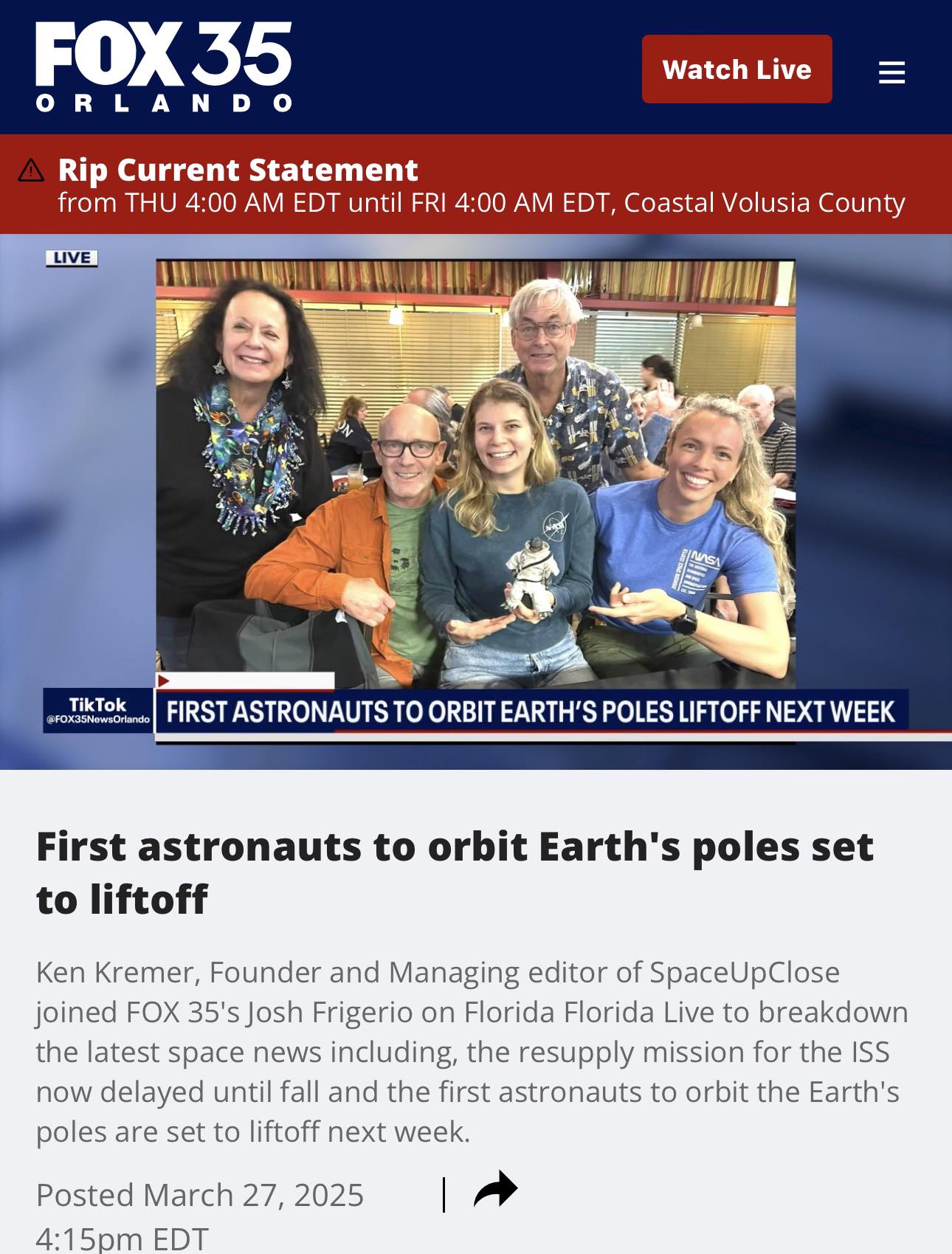
For SpaceUpClose.com & RocketSTEM
KENNEDY SPACE CENTER, FL – NASA’s uncrewed Orion spacecraft reached the farthest distance from Earth it will travel during the groundbreaking Artemis 1 mission — while also reaching the halfway mark of the flight during Flight Day 13, on Monday, Nov. 28 of the 25.5 day long test flight.
The spacecraft also captured stunning imagery of Earth and the Moon throughout the day, including of the Moon appearing to eclipse Earth.
All 8 billion humans are here together as one folk!
The awesome imagery was captured by a camera mounted on Orion’s solar arrays.
Orion was traveling 268,563 miles from our home planet, and 43,138 miles from the Moon, while cruising at 1,679 miles per hour — just after 4 p.m. EST, Nov 28.
The previous human spaceflight distance record of 248,654 miles, was set by the Apollo 13 crew all the way back in 1970, and just exceeded on Saturday, Nov. 26.
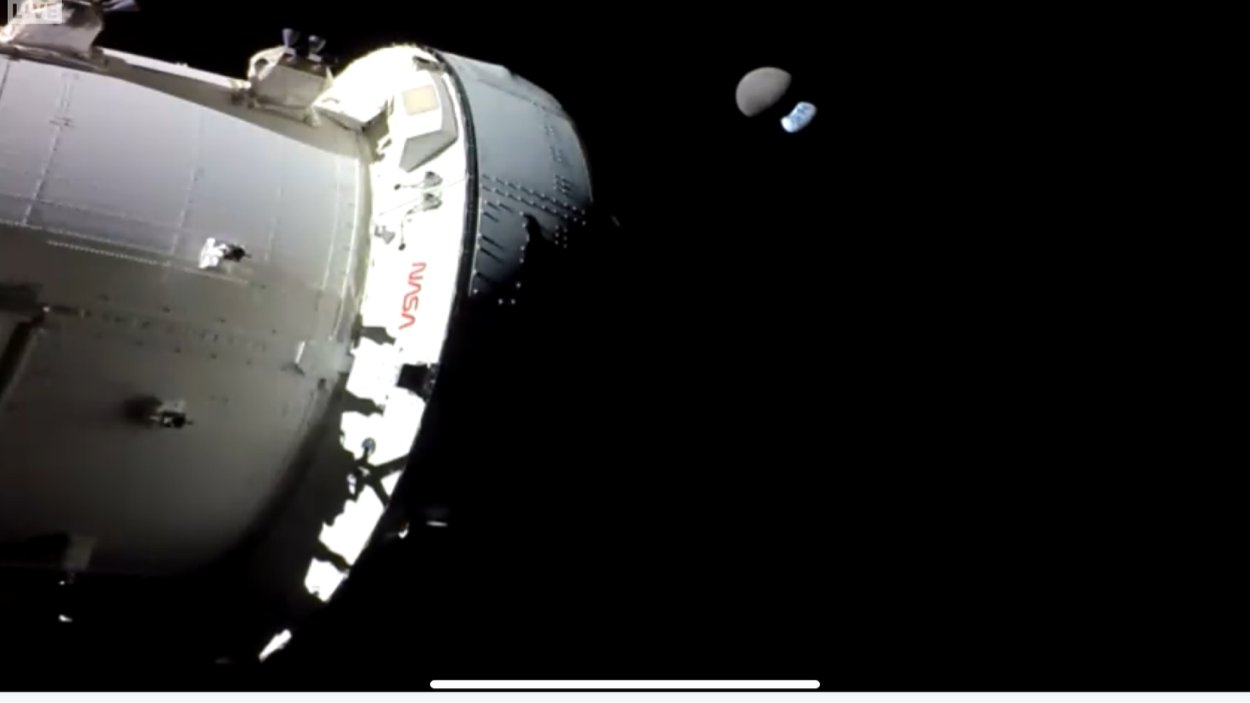
NASA reports that Orion remains in healthy condition as it continues its journey in the distant retrograde orbit portion of the mission – an approximately six-day leg of its larger mission thousands of miles beyond the Moon.
“Because of the unbelievable can-do spirit, Artemis 1 has had extraordinary success and completed a series of history-making events. Artemis builds on Apollo,” said NASA Administrator Bill Nelson, at the Nov. 28 media briefing.
“Not only are we going faster and farther, but Artemis is paving the way to live and work in deep space in a hostile environment, to invent, to create and ultimately to go on with humans to Mars.”
“It’s incredible just how smoothly this mission has gone, but this is a test. That’s what we do – we test it and we stress it.”
To date at the halfway point the Artemis 1 mission has performed flawlessly – with no significant technical issues arising
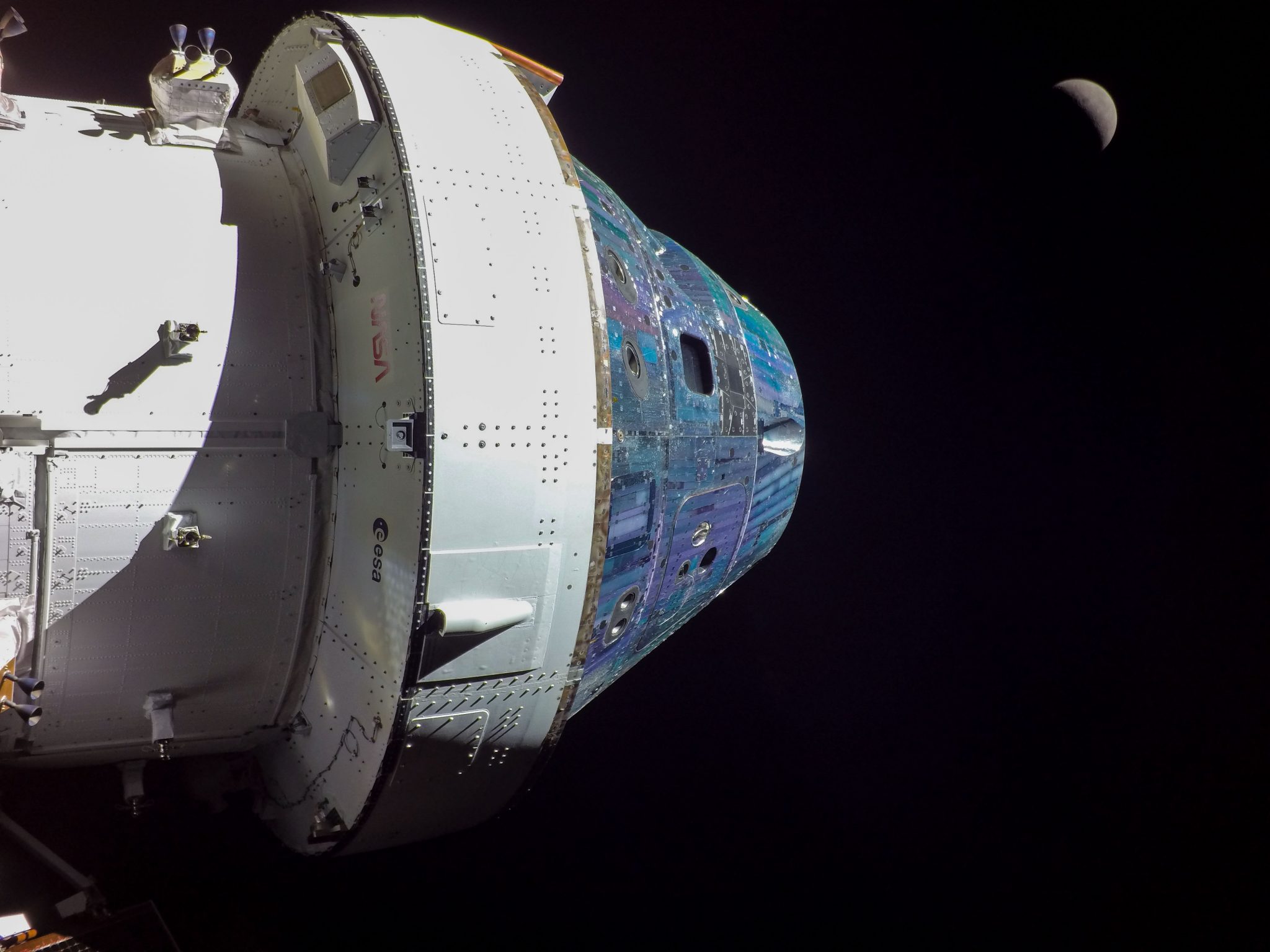
“The spacecraft is operating just tremendously well so far, and we’re really happy with its performance overall across all the subsystem areas,” said Howard Hu, NASA’s Orion program manager at the Johnson Space Center in Houston, at the media briefing.
The flight path is so on target that the team cancelled a planned orbital maintenance burn today (Nov. 28).
Engineers had originally planned an orbital maintenance burn today but determined it was not necessary because of Orion’s already precise trajectory in distant retrograde orbit, tha NASA team explained at the briefing.
They also added 7 additional objectives!
“Based on Orion’s performance, managers are examining adding seven additional test objectives to further characterize the spacecraft’s thermal environment and propulsion system to reduce risk before flying future missions with crew. To date, flight controllers have accomplished or are in the process of completing 37.5% of the test objectives associated with the mission, with many remaining objectives set to be evaluated during entry, descent, splashdown, and recovery.”
When the photos came back of the Earth being eclipsed by the Moon in deep space the NASA flight control team was absolutely mesmerized by the awesome celestial display.
“I was in the control center for a majority of those images, the ones including the Earth and the moon, and it’s really hard to articulate what the feeling is,” said Flight Director Rick LaBrode, at the briefing.
“It’s just amazing to be here and see that.”
Watch this short NASA video of the eclipsing Moon and Earthe taken by a camera mounted on Orion’s solar arrays.
Also watch the link leading to a live Artemis 1 stream from Orion
This is RIGHT NOW. @NASA_Orion is looking back at Earth and the Moon from distant retrograde orbit. Watch the #Artemis I livestream: https://t.co/Qx1QFUdD08 pic.twitter.com/zMTorYQvjS
— NASA (@NASA) November 28, 2022
Upcoming next on Dec. 1, the spacecraft will harness the Moon’s gravitational force once again, combined with a precisely timed lunar flyby burn called the distant retrograde orbit departure burn to slingshot Orion onto its return course to Earth and then on Dec. 5 the return powered flyby (RPF) burn ahead of splashdown in the Pacific Ocean on Sunday, Dec. 11.
Orion entered its a distant retrograde orbit (DRO) trajectory around the Moon after completing a critical thruster firing on Friday afternoon, Nov. 25, of the OMS main engine also required for the lunar orbit insertion firing on Flight Day 10 of the Artemis 1 unpiloted test flight mission.

The OMS engine utilized for the DRO burn propelled Orion at 363 feet per second Or and is attached to the base of the Service Module built by the European Space Agency (ESA) in a collaborative effort with NASA’s Project Artemis, who’s goal is to return astronauts to the surface of the Moon later this decade.
Orion’s Orbital Maneuvering System (OMS) engine performed an 88-second-long burn at 4:52 p.m. EST (2152 GMT) while firing to provide about 6000 pounds of thrust to slingshot Orion around the Moon and insert the spacecraft into the distant retrograde orbit while traveling over 2250 mph – that will take it farther from Earth than any of the Apollo lunar capsules and farther than any human rated capsule ever.

Orion was approximately 237, 680 miles from Earth and 57,000 miles from the Moon at the time of the DRO burn.
Orion will remain in DRO orbital trajectory for a half loop around the Moon over the next six days in order to test and monitor key systems and perform numerous checkouts in a deep space environment about traveling some 40,000 miles above the lunar surface before beginning the journey back to Earth, says NASA.
The OMS engines are recycled from the space shuttle and repurposed for Orion. This OMS engine flew on 19 shuttle missions between 1984 and 2002.
The DRO insertion burn took place four days after Orion successfully completed its outbound powered flyby (OPF) engine burn Monday, Nov. 21 and made its closest flyby of the Moon at an altitude of about 81 miles – thereby keeping the human space vehicle and Artemis 1 mission precisely on track for targeting the distant retrograde orbit (DRO) trajectory.

OPF took place just five days after the spectacular thunderous blastoff from the Kennedy Space Center (KSC) in Florida.
The test flight of the uncrewed Orion capsule began with the stunning debut liftoff of NASA Space Launch System (SLS) mega moon rocket on the Artemis 1 mission at 1:47 a.m. EST (0647 GMT) Wednesday, Nov. 16 from Launch Pad 39B at the Kennedy Space Center in Florida – sending America to the moon with the 1st human rated capsule in 50 years.
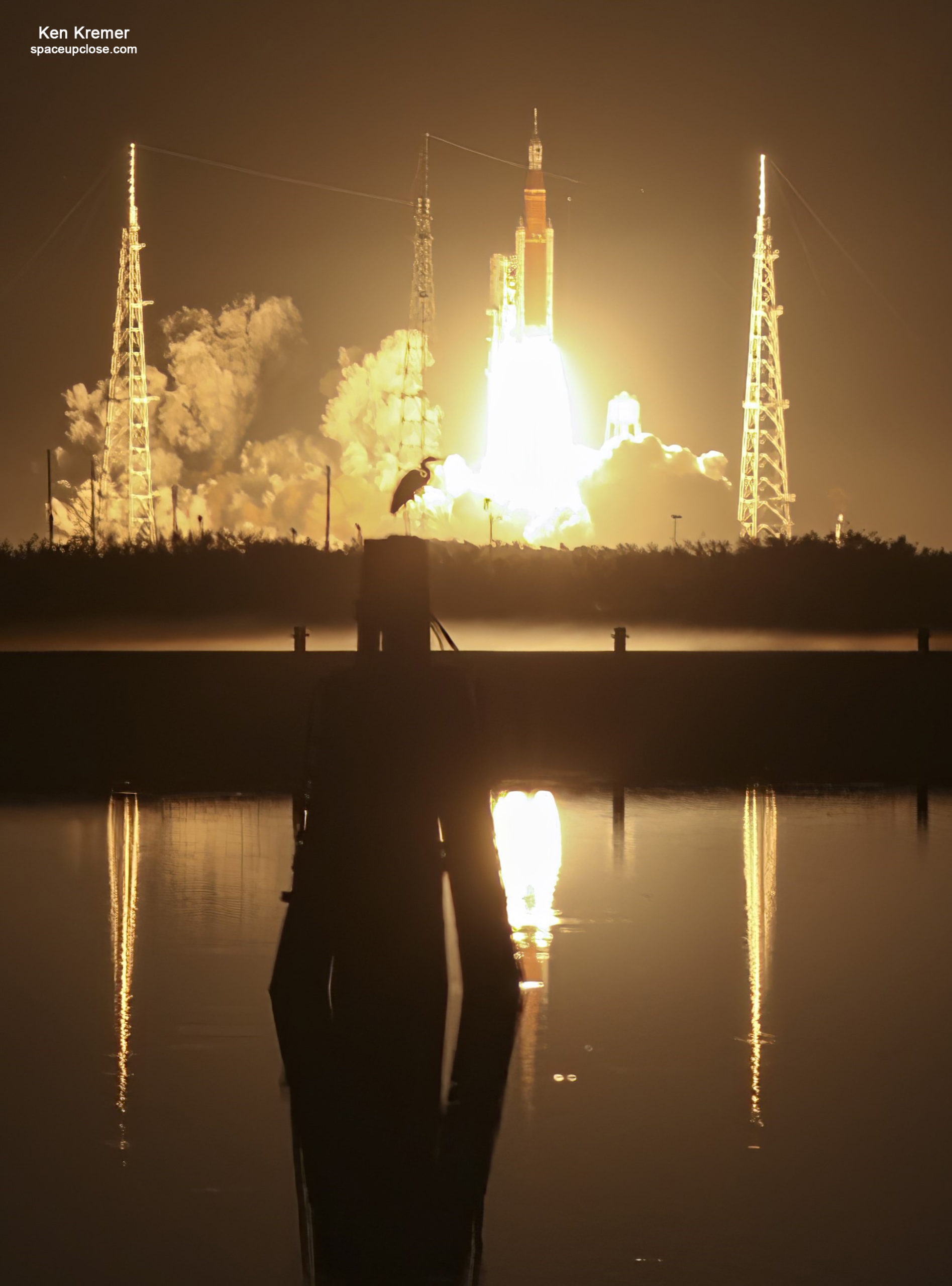
SLS now counts as the world’s the most powerful rocket ever built – about 15 to 20% more powerful than NASA’s Apollo Saturn V moon rocket and the Space Shuttle.
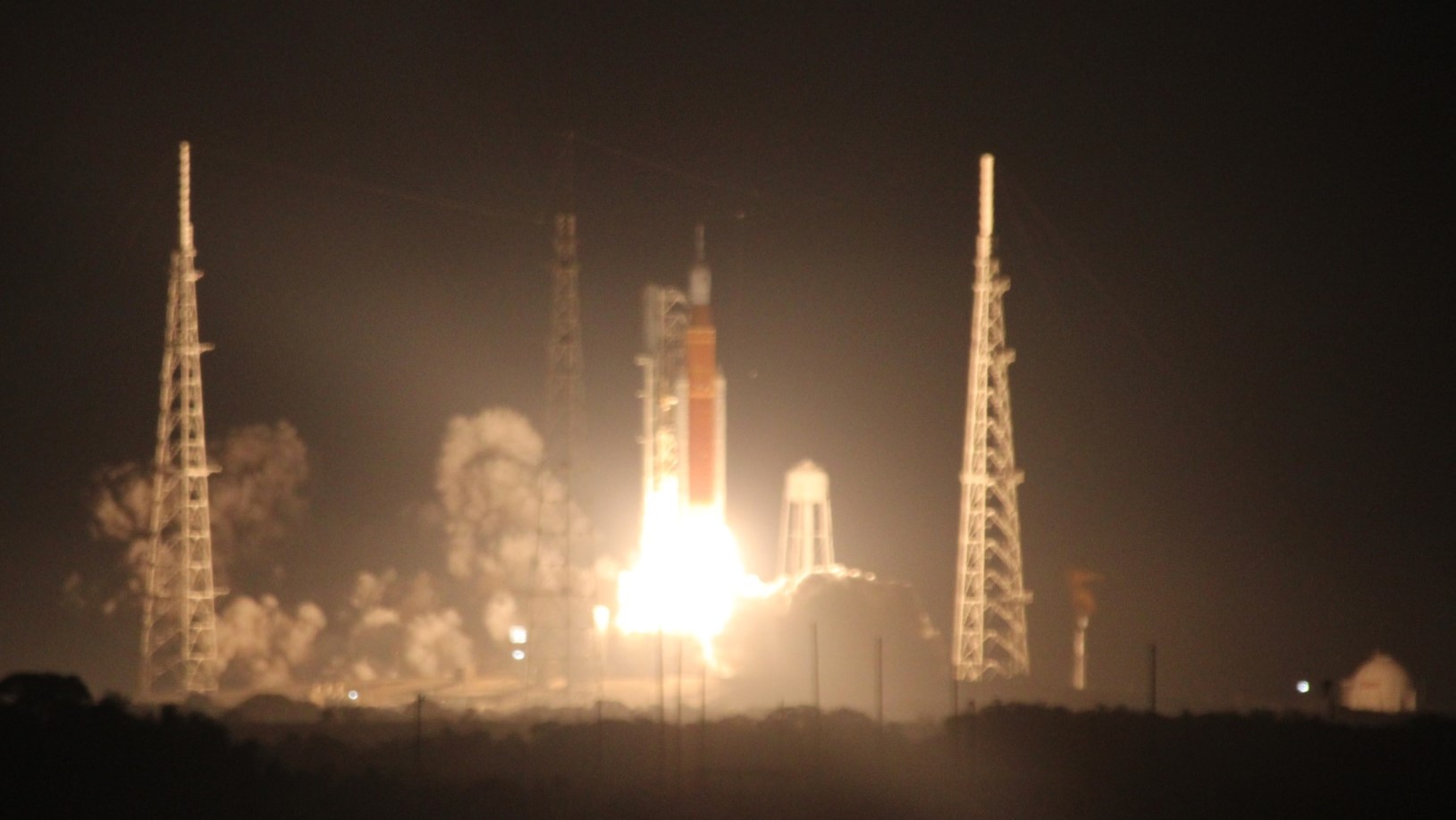
The primary objectives for the Artemis 1 mission that must be accomplished following the successful launch and delivery by the SLS moon rocket are: demonstrating Orion’s heat shield at lunar return re-entry conditions, demonstrating operations and facilities during all mission phases, and retrieving the spacecraft after splashdown.

Artemis 1 is the first integrated flight test of the agency’s deep space exploration systems: the Orion spacecraft, Space Launch System (SLS) rocket, and ground systems and the mission is a critical part of NASA’s Moon to Mars exploration strategy.
The 32-story tall Artemis 1 stack is comprised of NASA’s Space Launch System (SLS) Mega moon rocket integrated with the Orion crew spacecraft on top.
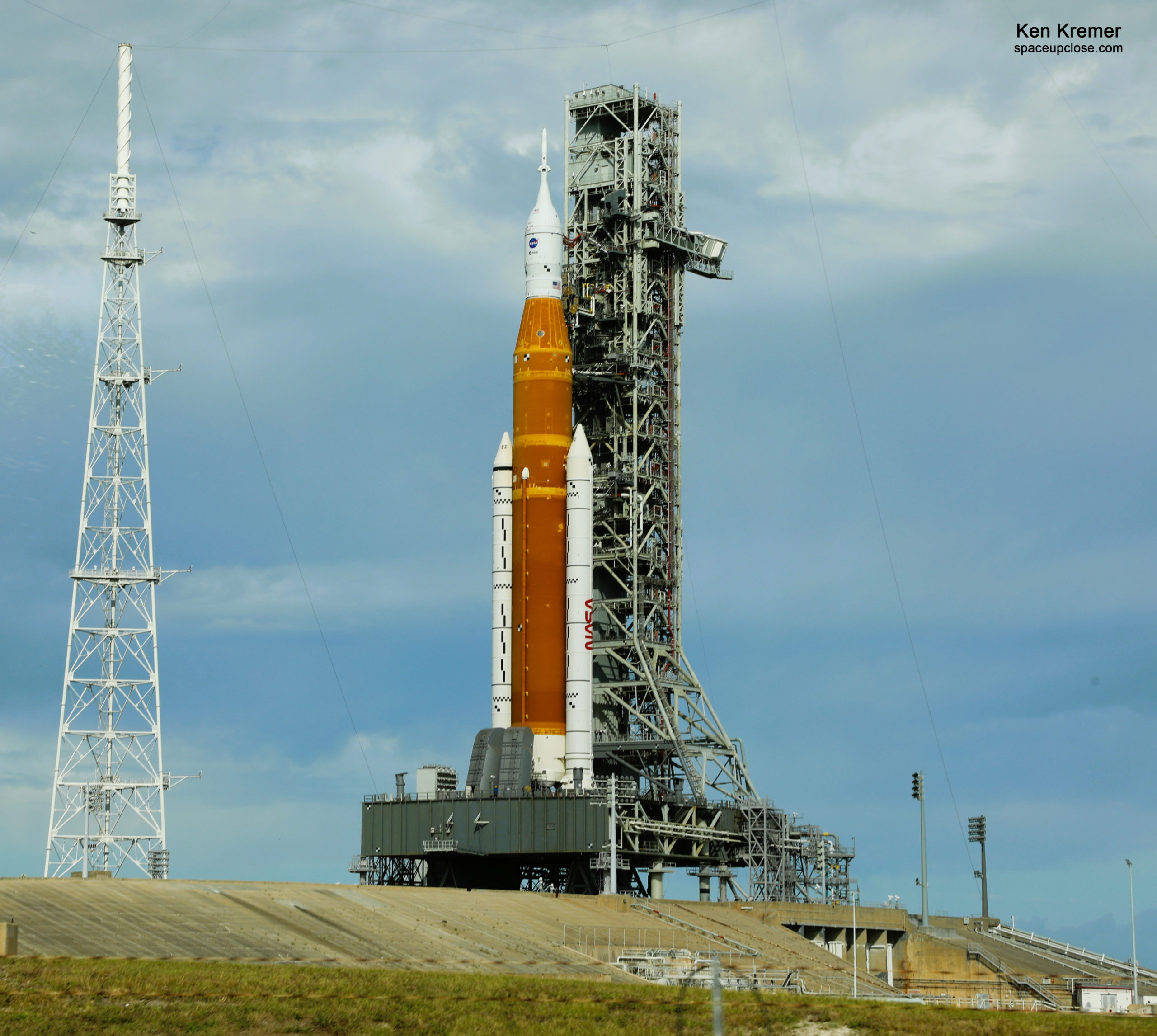
Watch Ken’s commentary about Project Artemis, SpaceX Falcon Heavy, Crew-5, NASA SLS cryo and WDR tests, NASA SpaceX Crew & Cargo Dragons and more
Nov 22: WFTV ABC News Orlando interview about upcoming NASA SpaceX CRS 26 cargo resupply mission to the ISS and science aboard + Artemis 1 launch and Orion crew capsule successfully entering lunar orbit, results and mission goals

Nov 22: Fox 35 interview about upcoming NASA SpaceX CRS 26 cargo resupply mission to the ISS and science aboard + Artemis 1 launch and Orion crew capsule successfully entering lunar orbit, results and mission goals
Nov 21: BBC World TV interview about Orion crew capsule successfully entering lunar orbit, results and mission goals
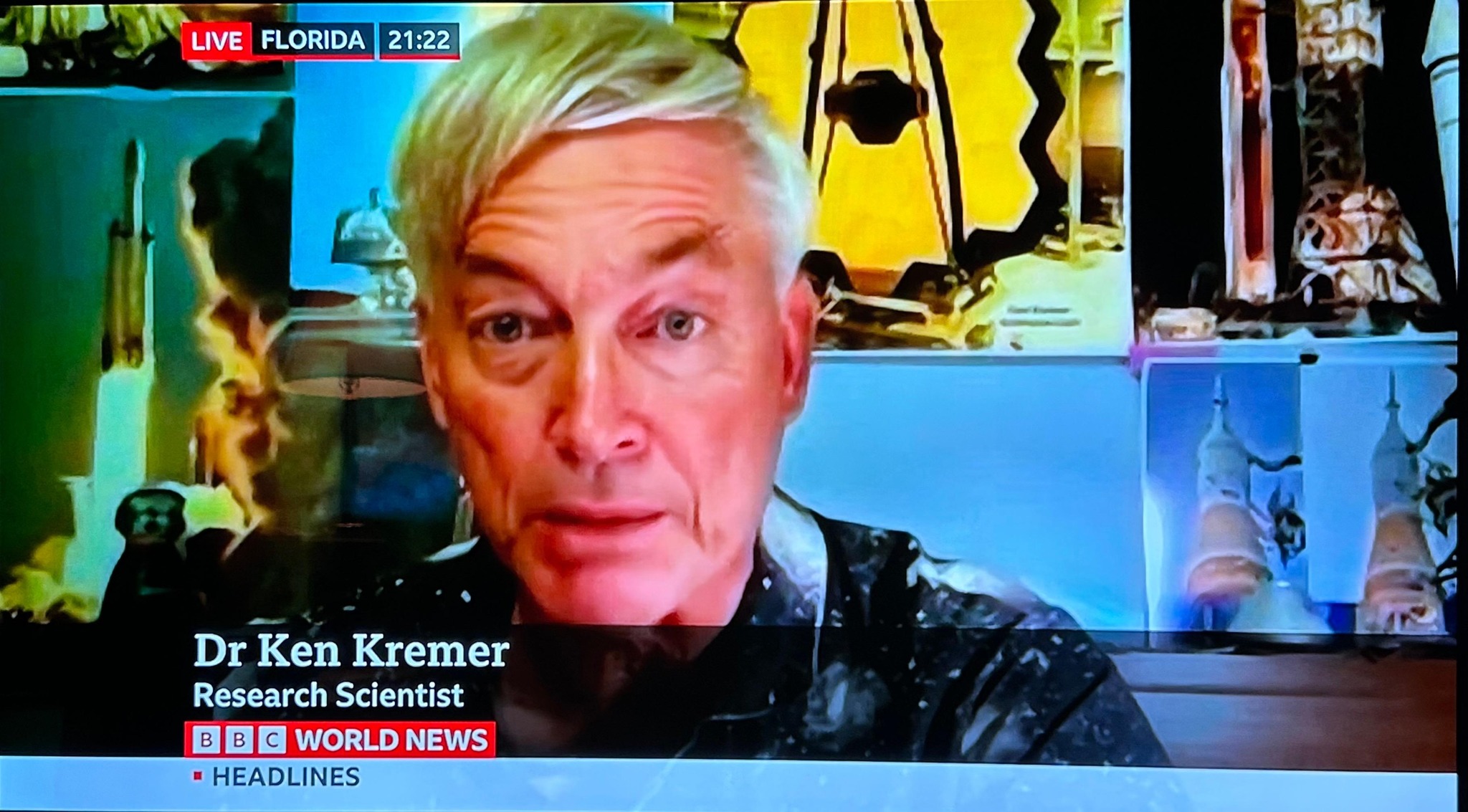
Nov 16: Fox 35 Orlando live and taped interviews about Artemis 1 launch and goals
Nov 15/16: News Nation interview about Artemis 1 launch and goals
Nov 7/8: Fox 35 Orlando – As subtropical storm Nicole approaches KSC and Florida watch my comments about NASA deciding for the moment to keep Artemis 1 moon rocket at pad 39b and not roll back to VAB
https://www.fox35orlando.com/news/nasa-says-its-keeping-artemis-outside-during-major-storm
NASA says it's keeping Artemis on the launch pad. The rocket can withstand winds up to 85 miles an hour. The @NWSMelbourne is predicting windspeeds could very well hit that point in Brevard County – in fact, a Tuesday morning update says windspeeds could be in the 74-110mph range pic.twitter.com/i569eAmi9p
— Marie Edinger FOX 35 (@MarieEdinger) November 8, 2022
Nov 4/5: WFTV ABC News Orlando featured my commentary about Artemis 1 rollout overnight and goals of NASA lunar test flight mission launching Nov 14 at 1207 AM
Nov 4: Fox 35 Orlando featured my commentary about Artemis 1 rollout overnight and goals of NASA lunar test flight mission launching Nov 14
Nov 1: Fox 35 Good Day Orlando morning show featured my live and taped prelaunch interview commentary about SpaceX Falcon Heavy launch with Space Force national security payloads
Nov 1: WFTV ABC News featured my commentary about SpaceX Falcon Heavy launch with Space Force national security payloads
https://news.yahoo.com/watch-lve-spacex-launches-falcon-100341265.html
Oct 31: WFTV ABC News featured my commentary about SpaceX Falcon Heavy launch with Space Force national security payloads
Oct 27: WFTV ABC News and Fox 35 Orlando featured my commentary about Falcon Heavy and the Space Force national security payloads
https://www.fox35orlando.com/video/1137117
Watch Ken’s continuing reports about Artemis, SpaceX missions, SLS, Orion and NASA missions, SpaceX Crew and Cargo Dragons, SpaceX Axiom, JWST, DART, Lucy Asteroid mission, GOES, SpaceX Starlink, Commercial Crew and Starliner and Crew Dragon, Blue Origin and Space Tourism, and onsite for live reporting of upcoming and recent SpaceX and ULA launches including Crew 1 & 2 & 3 & 4 & 5, ISS, Solar Orbiter, Mars 2020 Perseverance and Curiosity rovers, NRO spysats and national security missions and more at the Kennedy Space Center and Cape Canaveral Space Force Station.
Stay tuned here for Ken’s continuing Earth and Planetary science and human spaceflight news: www.kenkremer.com –www.spaceupclose.com – twitter @ken_kremer – email: ken at kenkremer.com
Dr. Kremer is a research scientist and journalist based in the KSC area, active in outreach and interviewed regularly on TV and radio about space topics.
………….
Ken’s photos are for sale and he is available for lectures and outreach events
Please consider supporting Ken’s work by purchasing his photos and/or donating at Patreon
https://www.patreon.com/kenkremer
Upcoming and recent space events and talks by Ken Kremer & Jean Wright
Nov 29 at UCF, Orlando Florida: Presentation by Jean Wright.
Nov 14/15/19/20/25/29 from 7 to 9 PM Quality Inn, Titusville, FL: Join Ken and Jean for Artemis 1, Falcon Heavy and space mission and rocket launch outreach. Ask us anything. plus display our photos and space apparel items for sale

x


